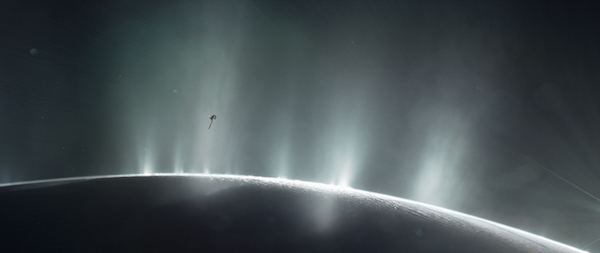MISSION
The End of Kepler – It’s not over yet but it will happen soon.

The Kepler space telescope, which was launched in March 2009, is the tenth NASA Discovery mission and the first dedicated to searching for and studying exoplanets. It was scheduled to operate for about four years, but is still active almost a decade later and after its scientific objectives changed when it was renamed the K2 mission. Despite these tremendous successes, scientists are now concerned about the health of the spacecraft, and a team of engineers and astronomers are working together in hopes of extending the spacecraft’s data-gathering capabilities for as long as possible.
In May 2013, loss of a second reaction... read more ❯
Another smoking gun in the search for life in Enceladus’ ocean

Today, NASA-funded scientists announced a major new step in the search for life on Enceladus, Saturn’s sixth-largest moon, thanks to new data collected by the NASA/ESA Cassini mission.
Enceladus has attracted a lot of interest because it has an active pole that spews jets of material into outer space. During its last flyby over that pole, an instrument on board the Cassini spacecraft detected the presence of a biomarker—molecular hydrogen. This suggests that the ocean we know lies beneath the moon’s surface could indeed contain an ecosystem similar to the ones we find in deep-sea hydrothermal vents on Earth.
[caption id="attachment_1938" align="aligncenter"... read more ❯
AGU Fall Meeting 2014: Solar System Small Bodies: Relics of Formation and New Worlds to Explore
Can you believe it is December already!? As usual, it is a busy month with the AGU Fall Conference. I co-organized a session on small solar system bodies with Padma Yanamandra-Fisher (PSI) and Julie Castillo (JPL). We will talk about recent discoveries in this emerging field including the discovery of rings around Chariklo, the understanding of regolith motion on asteroids, the new lander for Hayabusa 2 (MASCOT) and off course adaptive optics observations of asteroids. Below more info. See you there!
Where: Thursday, December 18, 2014 01:40 PM - 03:40 PM
When: Moscone West 3002
Why: The composition and physical properties of Small Solar System Bodies (SSSBs), remnants... read more ❯
House Hearings Fail to Tap NASA's Full Potential
Yesterday the U.S. House of Representatives Subcommittee on Space held a hearing entitled "Exploring Our Solar System: The ASTEROIDS Act as a Key Step Planetary science". I was curious about this act and expected the hearing to focus on interesting new ways to motivate private companies to design, launch, and operate space missions, and further the study of our Solar System.
The five witnesses chosen to testify included a NASA civil servant, three well-known planetary scientists and one... read more ❯
54 years of space exploration: an updated map that you must see
National Geographic asked 5W Infographics to update its 50 Years of Exploration graphic, a classic that I use often in my talks to illustrate our space exploration program and its focus on the inner part of the solar system.
The updated version, renamed "Cosmic Journey", is spectacular, better organized and easier to follow than its predecessor. It has been updated to include new missions sent over the past 4 years. The new color code includes the paths of failed, as well as successful, missions and also the nation that led them.
Cosmic Journey by Sean McNaughton, Samuel Velasco,... read more ❯
Mercury Craters named after world renowned artists, musicians and authors
Adapted from MESSENGER Mission News (March 26, 2013)
The International Astronomical Union (IAU) — the arbiter of planetary and satellite nomenclature since its inception in 1919 — recently approved a proposal from the MESSENGER Science Team to assign names to nine impact craters on Mercury. In keeping with the established naming theme for craters on Mercury, all of the newly designated features are named after famous deceased artists, musicians, or authors or other contributors to the humanities.
[caption id="attachment_1643" align="alignnone" width="500" caption="Global map of Mercury recently released by the NASA Messenger team. The globe on the left was created from the MDIS monochrome... read more ❯
Live-Tweets of Jim Green Presentation at OPAG
A few days ago, I received in my email the following message from the Division for Planetary Sciences.
Community Urged To Hear NASA's Jim Green Presentation On 10 January
There has been much discussion of NASA's Planetary Science Division (PSD) budget in recent weeks (about R&A in particular). Next week, Jim Green will give a presentation at the OPAG meeting in Atlanta about this, at 8:30 am on 10 January 2013. We strongly encourage our membership to call in via webcast to hear what he has to say, and to educate themselves about the current and upcoming PSD budget, including R&A. You... read more ❯
China joined the interplanetary club by successfully imaging the asteroid Toutatis
This exceptional result was brought to my attention late on Friday evening, but it clearly deserves a short post on this blog. Chang'E 2, a chinese mission dedicated to the exploration of the moon was recycled to explore the Near-Earth Asteroid (4179) Toutatis and succeeded.
Launched on October 1, 2010 aboard a Long March 3C rocket, the probe was in lunar orbit until August 25, 2011. The spacecraft is equipped with several instruments, such as stereo camera, Laser altimeter, Gamma/X-ray Spectrometers and a Microwave Detector. To date, no... read more ❯
The social media impact of NASA and other scientific institutions
Yesterday, my SETI Institute colleagues and I had a discussion about the importance of NASA in the minds of people in the USA, and around the world. The achievements of NASA are definitely universal and the latest interest of people for Curiosity, the car-sized rover which landed recently on Mars, is a vivid example. It is inspirational for the scientists to see that our friends and family follow with interest, the development of the mission, its challenging landing, the first step of the rover, and more recently its first self-portrait.
The NASA planetary exploration program is a superb scientific and exploration endeavor,... read more ❯
Kepler-16: Exoplanets around binary star systems DO exist
Kepler-16 is another great discovery coming from the Kepler telescope, the 10th NASA Discovery mission which is devoted to finding Earth-size exoplanets by monitoring variations of brightness due to transit. Today the Kepler team found a circumbinary exoplanet, an exoplanet orbiting a binary star system. Did they find Tatooine?
In the large 105 deg2 field of view of the Kepler spacecraft, ~156,000 stars are being almost continuously observed by the 0.95m telescope. In 2010, the star number KIC... read more ❯
NASA announced key pre-selected Discovery Missions
Today NASA announced three future key missions preselected as part of the Discovery program named GEMS, TiME and Comet Hopper. This is an important announcement, which was anxiously eagerly expected by our community.
The NASA Discovery program is a low-cost mission ($425 million FY2010) program aimed at developing and support well-defined and narrow-range science mission in the field of planetary exploration. Discovery is a dynamic and highly valuable program which had led to a lot of well-known missions with a wide range of scientific goals including (adapted from Visions & Voyages Decadal survey):
- NEAR Showmaker (Feb 1996) to rendezvous the Near... read more ❯
A Valentine night with Tempel-1 ?
Today is the night of Valentine day, I am not particularly romantic but I always tried to do something special for this day. Unfortunately, this year Valentine day is a disaster since I have several deadlines including an important paper which needs to be submitted before midnight.
At 10:50pm PST, my student (E. Enriquez) and I found out that Icarus Journal changed the rules of publication and we have to submit a final, high quality version, of each figure of this paper about the binary asteroid (90) Antiope. While my student is driving back to our office to make those... read more ❯
SETI REU students 2010 - "This is the end..."
Three weeks ago was the final week of the SETI REU students. It was a busy time for all of us since they had to wrap-up their work, write their report, and give their final presentations. Keaton Burns from UC Berkeley and Bill Freeman from LSU, who worked under my supervision in this program, did a fantastic work over this 10-week internship.
Since SETI Institute is a non-profit organization, it is not easy for the SETI researchers to find, attract... read more ❯
A picture of our home taken from Mercury's orbit
Just a short post today. I am still recovering from the SETIcon. I will tell you more about it soon. An image is worth a thousand words so just look at this picture taken by Messenger Spacecraft.
The Messenger spacecraft is looking for Vulcanoids, an hypothetical population of asteroids which could be orbiting between Mercury and the Sun. Messenger is a space mission currently in orbit around the Sun which a perihelion nearby the... read more ❯
